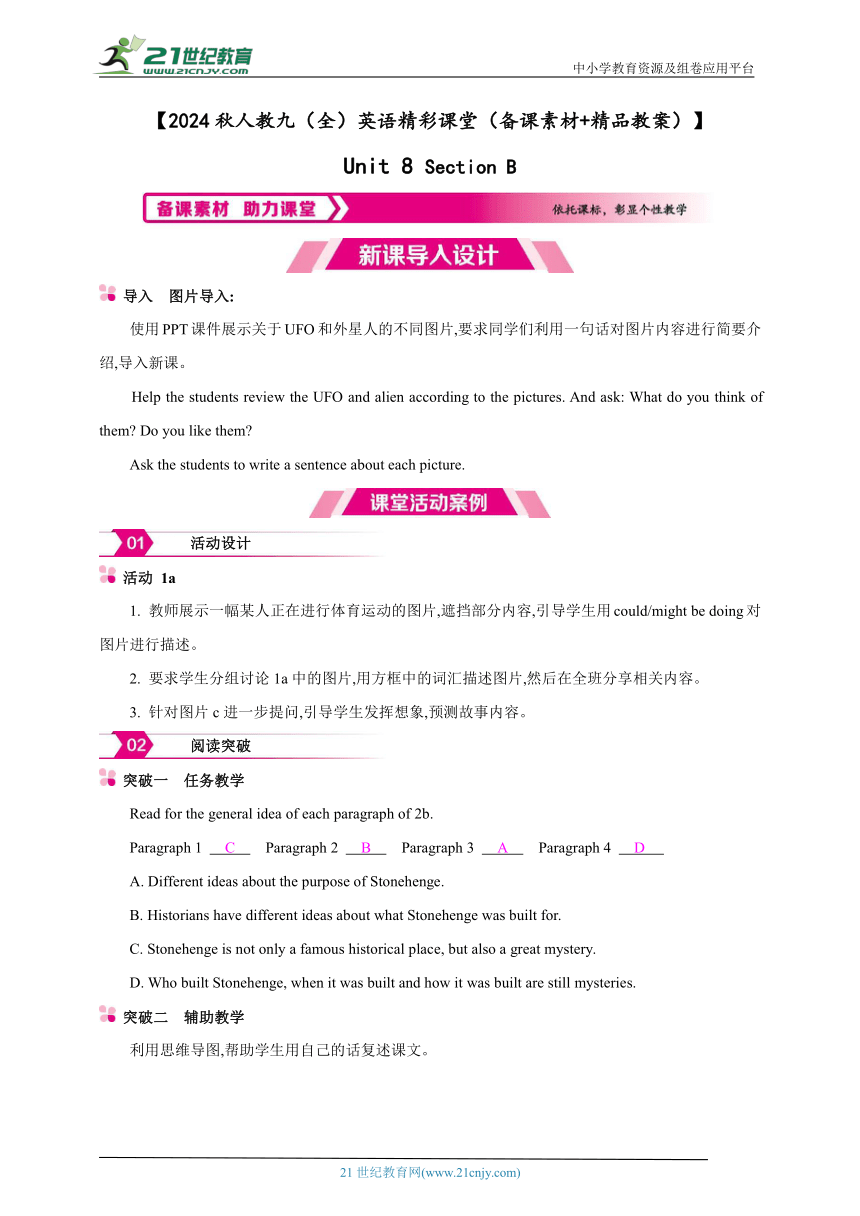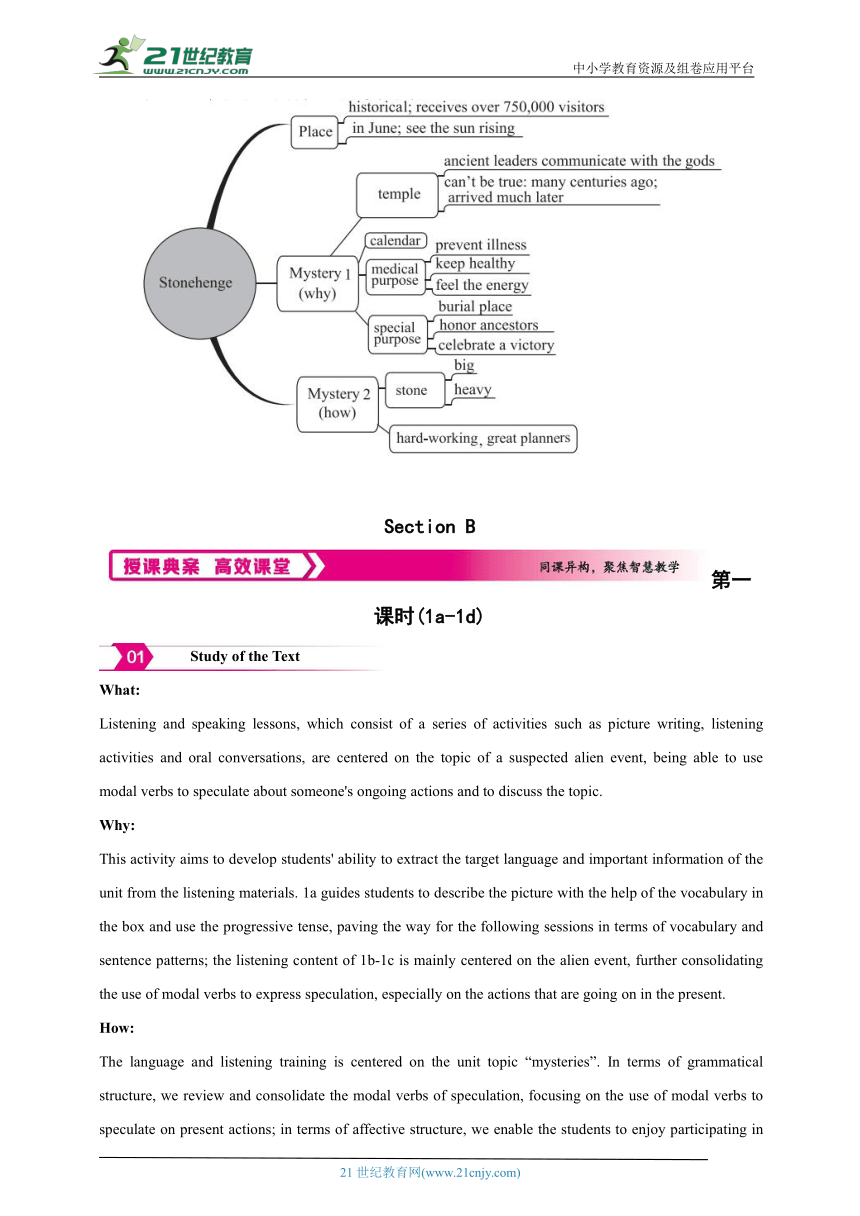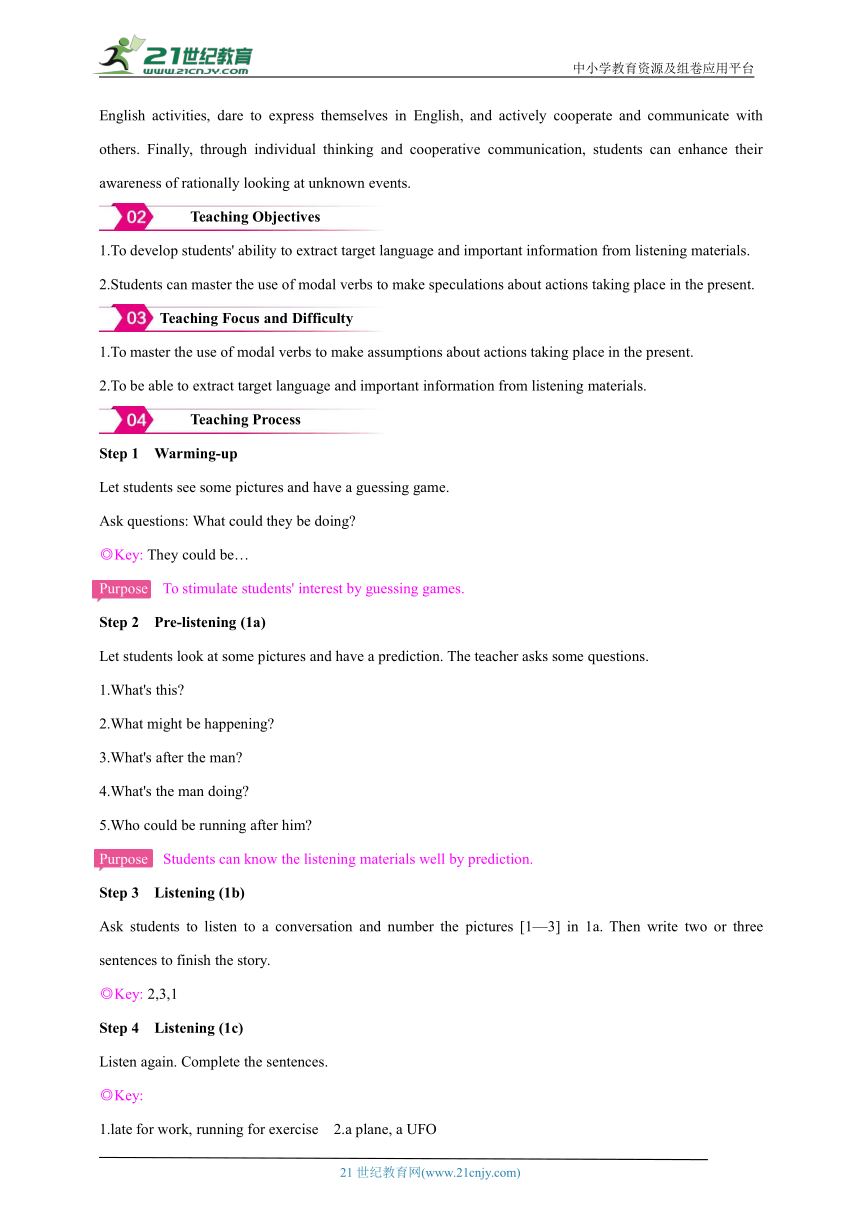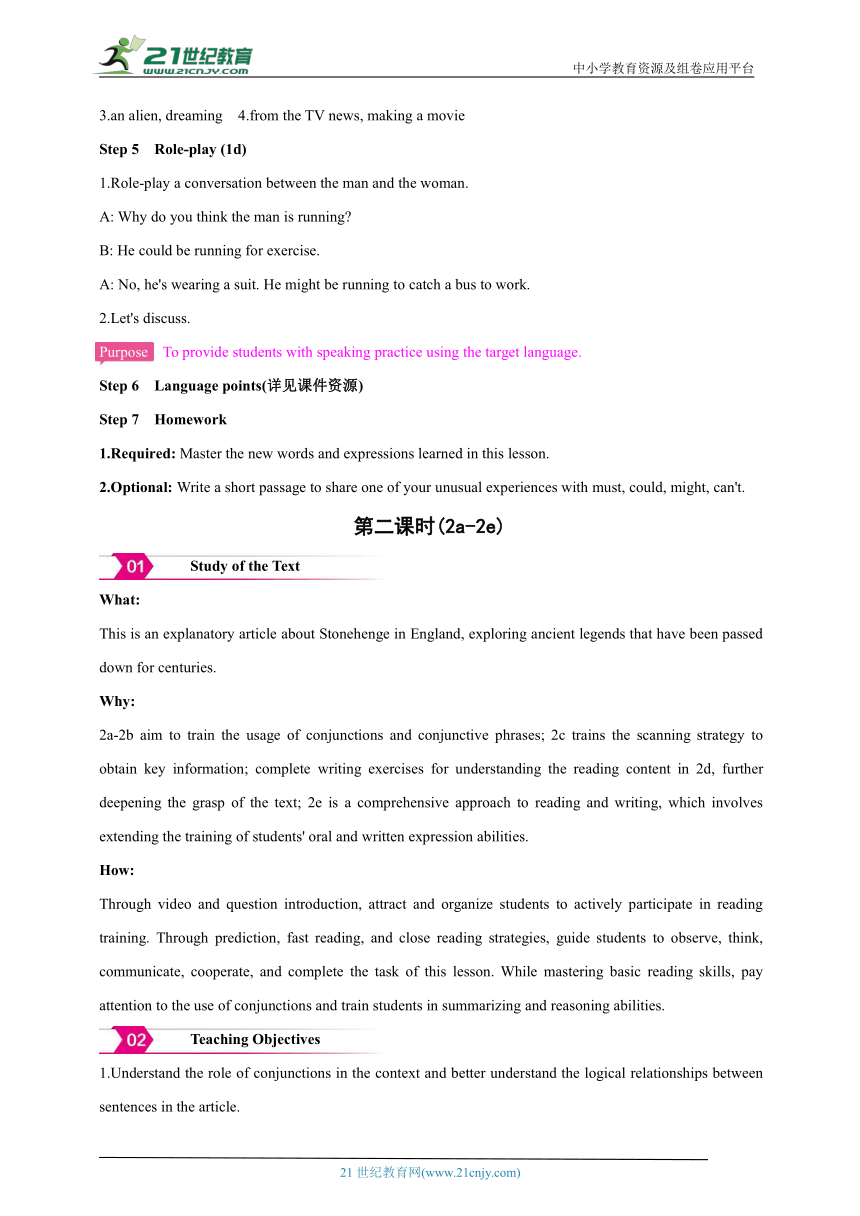Unit 8 It must belong to Carla section B【英语精彩课堂(备课素材+精品教案)】2024秋人教九(全)
文档属性
| 名称 | Unit 8 It must belong to Carla section B【英语精彩课堂(备课素材+精品教案)】2024秋人教九(全) |  | |
| 格式 | docx | ||
| 文件大小 | 661.7KB | ||
| 资源类型 | 试卷 | ||
| 版本资源 | 人教新目标(Go for it)版 | ||
| 科目 | 英语 | ||
| 更新时间 | 2024-11-12 15:09:28 | ||
图片预览




文档简介
中小学教育资源及组卷应用平台
【2024秋人教九(全)英语精彩课堂(备课素材+精品教案)】
Unit 8 Section B
导入 图片导入:
使用PPT课件展示关于UFO和外星人的不同图片,要求同学们利用一句话对图片内容进行简要介绍,导入新课。
Help the students review the UFO and alien according to the pictures. And ask: What do you think of them Do you like them
Ask the students to write a sentence about each picture.
活动设计
活动 1a
1. 教师展示一幅某人正在进行体育运动的图片,遮挡部分内容,引导学生用could/might be doing对图片进行描述。
2. 要求学生分组讨论1a中的图片,用方框中的词汇描述图片,然后在全班分享相关内容。
3. 针对图片c进一步提问,引导学生发挥想象,预测故事内容。
阅读突破
突破一 任务教学
Read for the general idea of each paragraph of 2b.
Paragraph 1 C Paragraph 2 B Paragraph 3 A Paragraph 4 D
A. Different ideas about the purpose of Stonehenge.
B. Historians have different ideas about what Stonehenge was built for.
C. Stonehenge is not only a famous historical place, but also a great mystery.
D. Who built Stonehenge, when it was built and how it was built are still mysteries.
突破二 辅助教学
利用思维导图,帮助学生用自己的话复述课文。
Section B
第一课时(1a-1d)
Study of the Text
What:
Listening and speaking lessons, which consist of a series of activities such as picture writing, listening activities and oral conversations, are centered on the topic of a suspected alien event, being able to use modal verbs to speculate about someone's ongoing actions and to discuss the topic.
Why:
This activity aims to develop students' ability to extract the target language and important information of the unit from the listening materials. 1a guides students to describe the picture with the help of the vocabulary in the box and use the progressive tense, paving the way for the following sessions in terms of vocabulary and sentence patterns; the listening content of 1b-1c is mainly centered on the alien event, further consolidating the use of modal verbs to express speculation, especially on the actions that are going on in the present.
How:
The language and listening training is centered on the unit topic “mysteries”. In terms of grammatical structure, we review and consolidate the modal verbs of speculation, focusing on the use of modal verbs to speculate on present actions; in terms of affective structure, we enable the students to enjoy participating in English activities, dare to express themselves in English, and actively cooperate and communicate with others. Finally, through individual thinking and cooperative communication, students can enhance their awareness of rationally looking at unknown events.
Teaching Objectives
1.To develop students' ability to extract target language and important information from listening materials.
2.Students can master the use of modal verbs to make speculations about actions taking place in the present.
Teaching Focus and Difficulty
1.To master the use of modal verbs to make assumptions about actions taking place in the present.
2.To be able to extract target language and important information from listening materials.
Teaching Process
Step 1 Warming-up
Let students see some pictures and have a guessing game.
Ask questions: What could they be doing
◎Key: They could be…
Purpose To stimulate students' interest by guessing games.
Step 2 Pre-listening (1a)
Let students look at some pictures and have a prediction. The teacher asks some questions.
1.What's this
2.What might be happening
3.What's after the man
4.What's the man doing
5.Who could be running after him
Purpose Students can know the listening materials well by prediction.
Step 3 Listening (1b)
Ask students to listen to a conversation and number the pictures [1—3] in 1a. Then write two or three sentences to finish the story.
◎Key: 2,3,1
Step 4 Listening (1c)
Listen again. Complete the sentences.
◎Key:
1.late for work, running for exercise 2.a plane, a UFO
3.an alien, dreaming 4.from the TV news, making a movie
Step 5 Role-play (1d)
1.Role-play a conversation between the man and the woman.
A: Why do you think the man is running
B: He could be running for exercise.
A: No, he's wearing a suit. He might be running to catch a bus to work.
2.Let's discuss.
Purpose To provide students with speaking practice using the target language.
Step 6 Language points(详见课件资源)
Step 7 Homework
1.Required: Master the new words and expressions learned in this lesson.
2.Optional: Write a short passage to share one of your unusual experiences with must, could, might, can't.
第二课时(2a-2e)
Study of the Text
What:
This is an explanatory article about Stonehenge in England, exploring ancient legends that have been passed down for centuries.
Why:
2a-2b aim to train the usage of conjunctions and conjunctive phrases; 2c trains the scanning strategy to obtain key information; complete writing exercises for understanding the reading content in 2d, further deepening the grasp of the text; 2e is a comprehensive approach to reading and writing, which involves extending the training of students' oral and written expression abilities.
How:
Through video and question introduction, attract and organize students to actively participate in reading training. Through prediction, fast reading, and close reading strategies, guide students to observe, think, communicate, cooperate, and complete the task of this lesson. While mastering basic reading skills, pay attention to the use of conjunctions and train students in summarizing and reasoning abilities.
Teaching Objectives
1.Understand the role of conjunctions in the context and better understand the logical relationships between sentences in the article.
2.Read short texts and be able to effectively obtain relevant information as required.
Teaching Focus and Difficulty
Teaching Focus:
1.Master the words and usage that appear during the lesson.
2.Read short articles to get relevant information and improve students' comprehensive reading ability.
Teaching Difficulty:
Read the short article in 2b and complete the related requirements.
Teaching Process
Step 1 Free-talk
T: Can you tell me what your dream job is
S: My dream job is to be a historian because I want to explore some mysteries.
Purpose To arouse students' interest and set the stage for reading the article.
Step 2 Pre-reading
Ask some questions about Stonehenge.
1.What do you know about this mystery
2.What do you think it was used for
Purpose Predict the main information of this article through the title and the picture before reading to reduce the difficulty of reading and stimulate students' reading curiosity.
Step 3 While-reading
1.Prediction
Tips: Get information from the title and the picture.
Ask the question: This article will talk about the mystery of Stonehenge .
Match the general idea with each paragraph.
Para.1 Why was Stonehenge built
Paras.2&3 How was Stonehenge built
Para.4 What is Stonehenge
2.Careful-reading: Read Para. 1 carefully and make a mind map.
3.Read Paras. 2 & 3 and find out what Stonehenge might be used for. Circle the key words.(详见课件资源)
4.Let's draw a mind map and introduce Stonehenge.
Purpose Set up a matching exercise for the main idea of each paragraph to deepen the understanding of the reading text as well as to further develop students' ability to grasp key information.
5.2a. Match each linking word or phrase with its purpose.(详见课件资源)
Purpose Summarizing through tables helps to develop reading skills.
6.Let's practice.
(1)Midsummer day is in June and a lot of people go to Stonehenge during this month.
(2)The sun shines straight into the center of Stonehenge as the stones were put in a special position.
(3)Some people think the rocks can not only stop people from becoming ill but also keep them healthy.
(4)We don't know who built Stonehenge or how it was built.
(5)Historians think Stonehenge was built about 5,000 years ago; however , they're not sure.
Purpose To deepen students' understanding of the passage and consolidate the details of the passage.
Step 4 Post-reading
Let's think.
1.Can you think of any other mysteries, either in China or another part of the world, which are similar to Stonehenge
2.What do you know about these mysteries
3.What is mysterious about them
Step 5 Language points(详见课件资源)
Explain language points in this class.
Step 6 Homework
1.Required: Master the new words and expressions learned in this lesson.
2.Optional: Suppose you are a guide, make up a conversation talking about Stonehenge(within 100 words). You need to use as many linking words or phrases as you can.
第三课时(Writing)
Step 1 Presentation
1.话题解读:
本单元以“Mysteries”为话题,该话题的写作命题通常采用“Guided Writing”形式,有的给出中文或英文内容提示,根据提示内容写作;也有的给出图画提示,根据图画内容,发挥合理想象,描述图片内容并连接成一个小故事。
2.常用句型:
It must be… 它必定是……
It might be… 它可能是……
It could belong to… 它可能属于……
It could/can't be… 它可能是/不可能是……
Step 2 Imagination
Ask the students to read the article in 3a on P59 again to refresh their memories. In small groups of four, get them to come up with different ideas on what might have caused the noises and why. And have the students fill in the following chart.
What could the noises be Why do you think so
And check their work with several groups.
Step 3 Guidance on writing methods
Step 4 Writing
1.Get the students to look at this newspaper headline in 3b and finish the article about the strange happenings according to the information in 3b.
2.Have the students pay attention to the writing tips.
Step 5 After-writing
After finishing the writing, get the students to check their work in pairs. And then ask some students to present their work to the class.
21世纪教育网 www.21cnjy.com 精品试卷·第 2 页 (共 2 页)
21世纪教育网(www.21cnjy.com)
【2024秋人教九(全)英语精彩课堂(备课素材+精品教案)】
Unit 8 Section B
导入 图片导入:
使用PPT课件展示关于UFO和外星人的不同图片,要求同学们利用一句话对图片内容进行简要介绍,导入新课。
Help the students review the UFO and alien according to the pictures. And ask: What do you think of them Do you like them
Ask the students to write a sentence about each picture.
活动设计
活动 1a
1. 教师展示一幅某人正在进行体育运动的图片,遮挡部分内容,引导学生用could/might be doing对图片进行描述。
2. 要求学生分组讨论1a中的图片,用方框中的词汇描述图片,然后在全班分享相关内容。
3. 针对图片c进一步提问,引导学生发挥想象,预测故事内容。
阅读突破
突破一 任务教学
Read for the general idea of each paragraph of 2b.
Paragraph 1 C Paragraph 2 B Paragraph 3 A Paragraph 4 D
A. Different ideas about the purpose of Stonehenge.
B. Historians have different ideas about what Stonehenge was built for.
C. Stonehenge is not only a famous historical place, but also a great mystery.
D. Who built Stonehenge, when it was built and how it was built are still mysteries.
突破二 辅助教学
利用思维导图,帮助学生用自己的话复述课文。
Section B
第一课时(1a-1d)
Study of the Text
What:
Listening and speaking lessons, which consist of a series of activities such as picture writing, listening activities and oral conversations, are centered on the topic of a suspected alien event, being able to use modal verbs to speculate about someone's ongoing actions and to discuss the topic.
Why:
This activity aims to develop students' ability to extract the target language and important information of the unit from the listening materials. 1a guides students to describe the picture with the help of the vocabulary in the box and use the progressive tense, paving the way for the following sessions in terms of vocabulary and sentence patterns; the listening content of 1b-1c is mainly centered on the alien event, further consolidating the use of modal verbs to express speculation, especially on the actions that are going on in the present.
How:
The language and listening training is centered on the unit topic “mysteries”. In terms of grammatical structure, we review and consolidate the modal verbs of speculation, focusing on the use of modal verbs to speculate on present actions; in terms of affective structure, we enable the students to enjoy participating in English activities, dare to express themselves in English, and actively cooperate and communicate with others. Finally, through individual thinking and cooperative communication, students can enhance their awareness of rationally looking at unknown events.
Teaching Objectives
1.To develop students' ability to extract target language and important information from listening materials.
2.Students can master the use of modal verbs to make speculations about actions taking place in the present.
Teaching Focus and Difficulty
1.To master the use of modal verbs to make assumptions about actions taking place in the present.
2.To be able to extract target language and important information from listening materials.
Teaching Process
Step 1 Warming-up
Let students see some pictures and have a guessing game.
Ask questions: What could they be doing
◎Key: They could be…
Purpose To stimulate students' interest by guessing games.
Step 2 Pre-listening (1a)
Let students look at some pictures and have a prediction. The teacher asks some questions.
1.What's this
2.What might be happening
3.What's after the man
4.What's the man doing
5.Who could be running after him
Purpose Students can know the listening materials well by prediction.
Step 3 Listening (1b)
Ask students to listen to a conversation and number the pictures [1—3] in 1a. Then write two or three sentences to finish the story.
◎Key: 2,3,1
Step 4 Listening (1c)
Listen again. Complete the sentences.
◎Key:
1.late for work, running for exercise 2.a plane, a UFO
3.an alien, dreaming 4.from the TV news, making a movie
Step 5 Role-play (1d)
1.Role-play a conversation between the man and the woman.
A: Why do you think the man is running
B: He could be running for exercise.
A: No, he's wearing a suit. He might be running to catch a bus to work.
2.Let's discuss.
Purpose To provide students with speaking practice using the target language.
Step 6 Language points(详见课件资源)
Step 7 Homework
1.Required: Master the new words and expressions learned in this lesson.
2.Optional: Write a short passage to share one of your unusual experiences with must, could, might, can't.
第二课时(2a-2e)
Study of the Text
What:
This is an explanatory article about Stonehenge in England, exploring ancient legends that have been passed down for centuries.
Why:
2a-2b aim to train the usage of conjunctions and conjunctive phrases; 2c trains the scanning strategy to obtain key information; complete writing exercises for understanding the reading content in 2d, further deepening the grasp of the text; 2e is a comprehensive approach to reading and writing, which involves extending the training of students' oral and written expression abilities.
How:
Through video and question introduction, attract and organize students to actively participate in reading training. Through prediction, fast reading, and close reading strategies, guide students to observe, think, communicate, cooperate, and complete the task of this lesson. While mastering basic reading skills, pay attention to the use of conjunctions and train students in summarizing and reasoning abilities.
Teaching Objectives
1.Understand the role of conjunctions in the context and better understand the logical relationships between sentences in the article.
2.Read short texts and be able to effectively obtain relevant information as required.
Teaching Focus and Difficulty
Teaching Focus:
1.Master the words and usage that appear during the lesson.
2.Read short articles to get relevant information and improve students' comprehensive reading ability.
Teaching Difficulty:
Read the short article in 2b and complete the related requirements.
Teaching Process
Step 1 Free-talk
T: Can you tell me what your dream job is
S: My dream job is to be a historian because I want to explore some mysteries.
Purpose To arouse students' interest and set the stage for reading the article.
Step 2 Pre-reading
Ask some questions about Stonehenge.
1.What do you know about this mystery
2.What do you think it was used for
Purpose Predict the main information of this article through the title and the picture before reading to reduce the difficulty of reading and stimulate students' reading curiosity.
Step 3 While-reading
1.Prediction
Tips: Get information from the title and the picture.
Ask the question: This article will talk about the mystery of Stonehenge .
Match the general idea with each paragraph.
Para.1 Why was Stonehenge built
Paras.2&3 How was Stonehenge built
Para.4 What is Stonehenge
2.Careful-reading: Read Para. 1 carefully and make a mind map.
3.Read Paras. 2 & 3 and find out what Stonehenge might be used for. Circle the key words.(详见课件资源)
4.Let's draw a mind map and introduce Stonehenge.
Purpose Set up a matching exercise for the main idea of each paragraph to deepen the understanding of the reading text as well as to further develop students' ability to grasp key information.
5.2a. Match each linking word or phrase with its purpose.(详见课件资源)
Purpose Summarizing through tables helps to develop reading skills.
6.Let's practice.
(1)Midsummer day is in June and a lot of people go to Stonehenge during this month.
(2)The sun shines straight into the center of Stonehenge as the stones were put in a special position.
(3)Some people think the rocks can not only stop people from becoming ill but also keep them healthy.
(4)We don't know who built Stonehenge or how it was built.
(5)Historians think Stonehenge was built about 5,000 years ago; however , they're not sure.
Purpose To deepen students' understanding of the passage and consolidate the details of the passage.
Step 4 Post-reading
Let's think.
1.Can you think of any other mysteries, either in China or another part of the world, which are similar to Stonehenge
2.What do you know about these mysteries
3.What is mysterious about them
Step 5 Language points(详见课件资源)
Explain language points in this class.
Step 6 Homework
1.Required: Master the new words and expressions learned in this lesson.
2.Optional: Suppose you are a guide, make up a conversation talking about Stonehenge(within 100 words). You need to use as many linking words or phrases as you can.
第三课时(Writing)
Step 1 Presentation
1.话题解读:
本单元以“Mysteries”为话题,该话题的写作命题通常采用“Guided Writing”形式,有的给出中文或英文内容提示,根据提示内容写作;也有的给出图画提示,根据图画内容,发挥合理想象,描述图片内容并连接成一个小故事。
2.常用句型:
It must be… 它必定是……
It might be… 它可能是……
It could belong to… 它可能属于……
It could/can't be… 它可能是/不可能是……
Step 2 Imagination
Ask the students to read the article in 3a on P59 again to refresh their memories. In small groups of four, get them to come up with different ideas on what might have caused the noises and why. And have the students fill in the following chart.
What could the noises be Why do you think so
And check their work with several groups.
Step 3 Guidance on writing methods
Step 4 Writing
1.Get the students to look at this newspaper headline in 3b and finish the article about the strange happenings according to the information in 3b.
2.Have the students pay attention to the writing tips.
Step 5 After-writing
After finishing the writing, get the students to check their work in pairs. And then ask some students to present their work to the class.
21世纪教育网 www.21cnjy.com 精品试卷·第 2 页 (共 2 页)
21世纪教育网(www.21cnjy.com)
同课章节目录
- Unit 1 How can we become good learners.
- Section A
- Section B
- Unit 2 I think that mooncakes are delicious!
- Section A
- Section B
- Unit 3 Could you please tell me where the restroom
- Section A
- Section B
- Unit 4 I used to be afraid of the dark.
- Section A
- Section B
- Unit 5 What are the shirts made of?
- Section A
- Section B
- Review of Units 1-5
- Unit 6 When was it invented?
- Section A
- Section B
- Unit 7 Teenagers should be allowed to choose their
- Section A
- Section B
- Unit 8 It must belong to Carla.
- Section A
- Section B
- Unit 9 I like music that I can dance to.
- Section A
- Section B
- Unit 10 You're supposed to shake hands.
- Section A
- Section B
- Review of Units 6-10
- Unit 11 Sad movies make me cry.
- Section A
- Section B
- Unit 12 Life is full of the unexpected
- Section A
- Section B
- Unit 13 We're trying to save the earth!
- Section A
- Section B
- Unit 14 I remember meeting all of you in Grade 7.
- Section A
- Section B
- Review of Units 11-14
